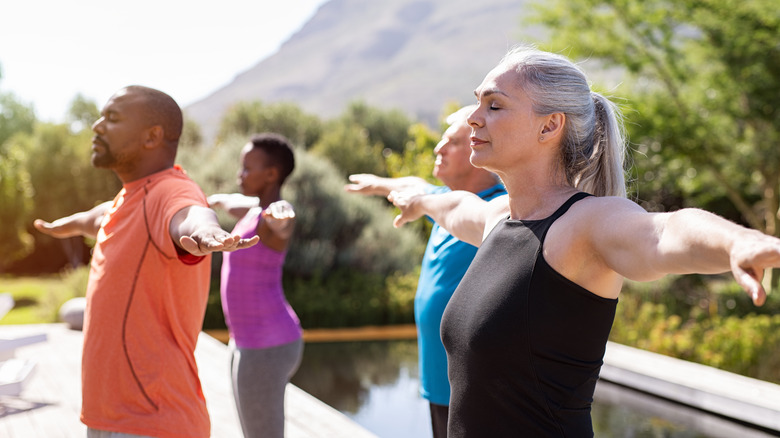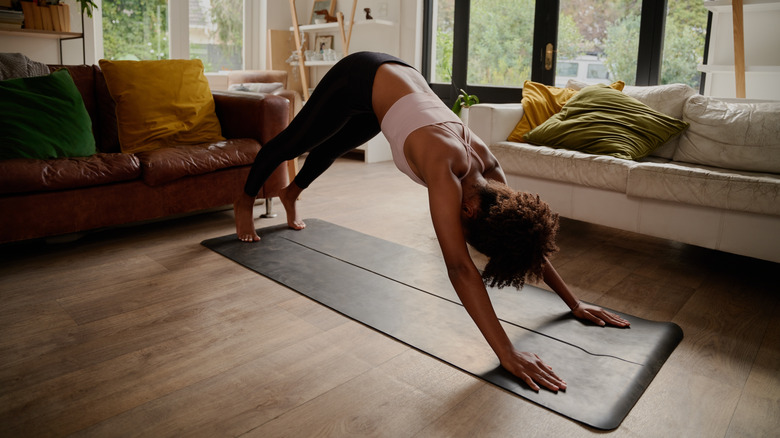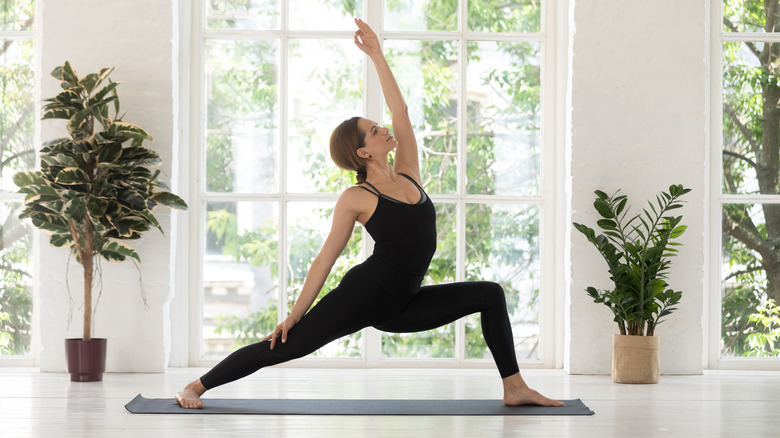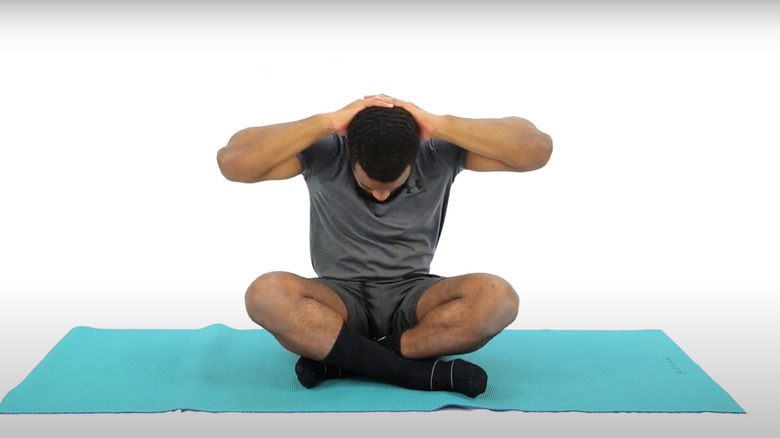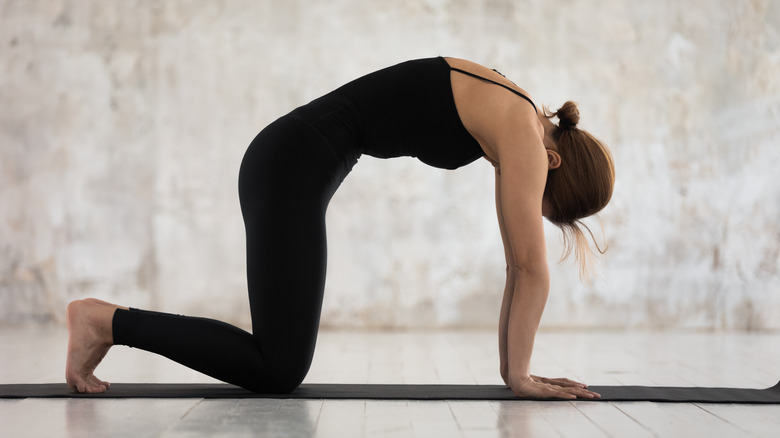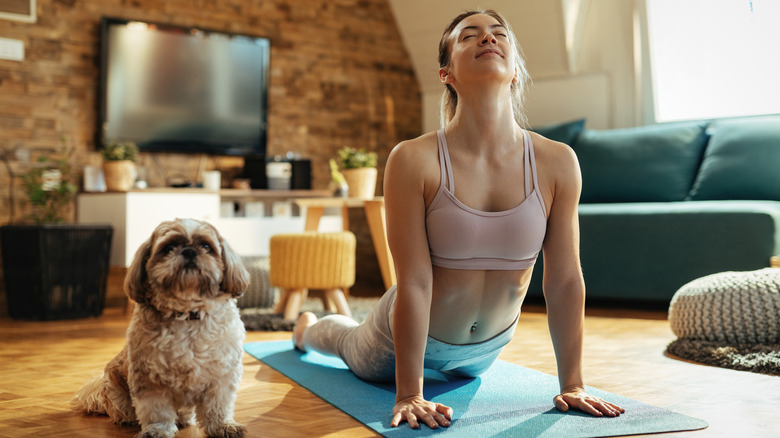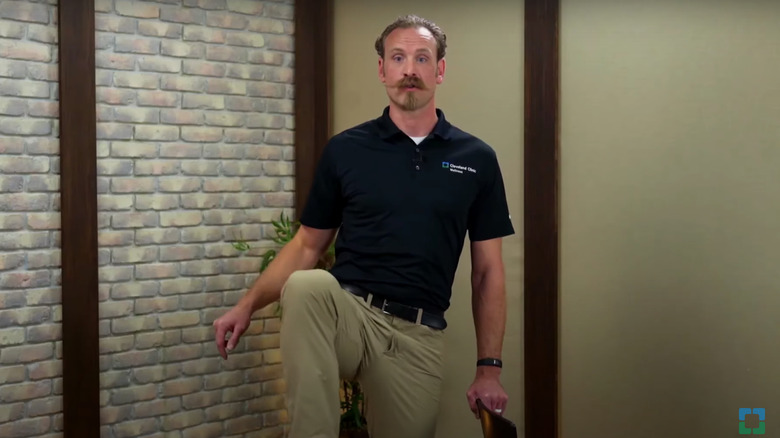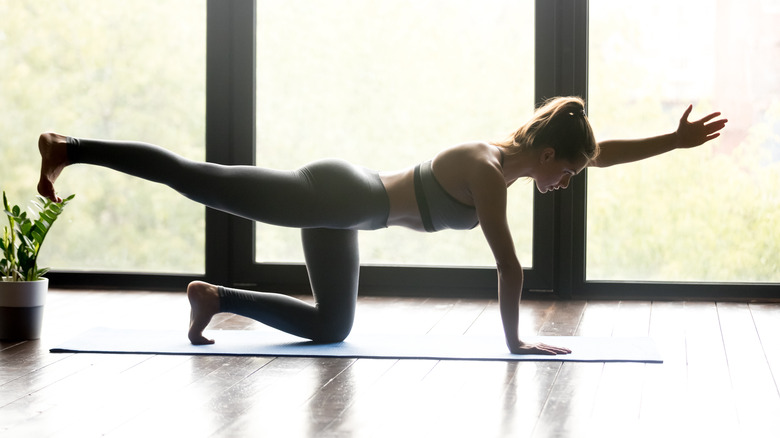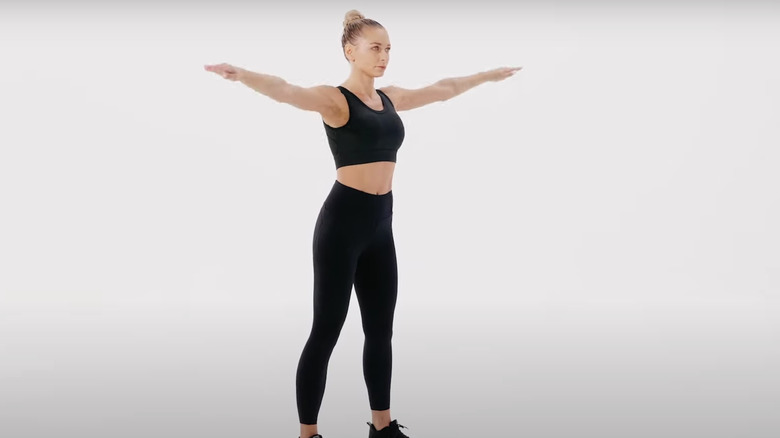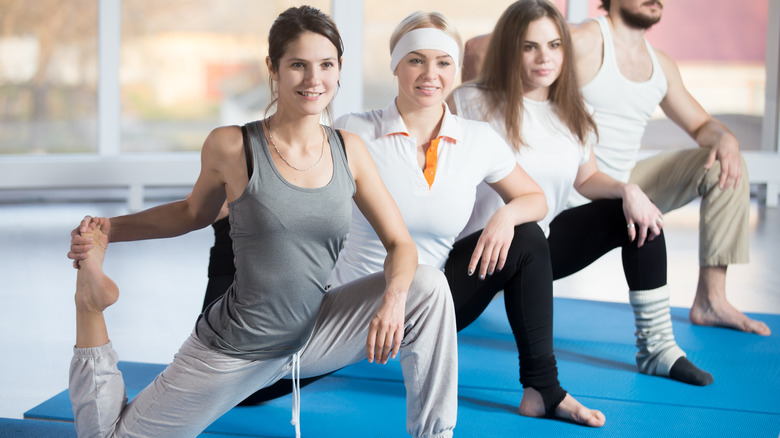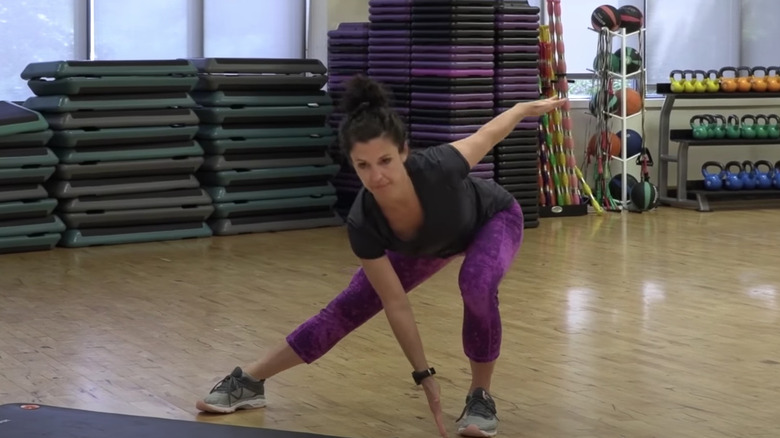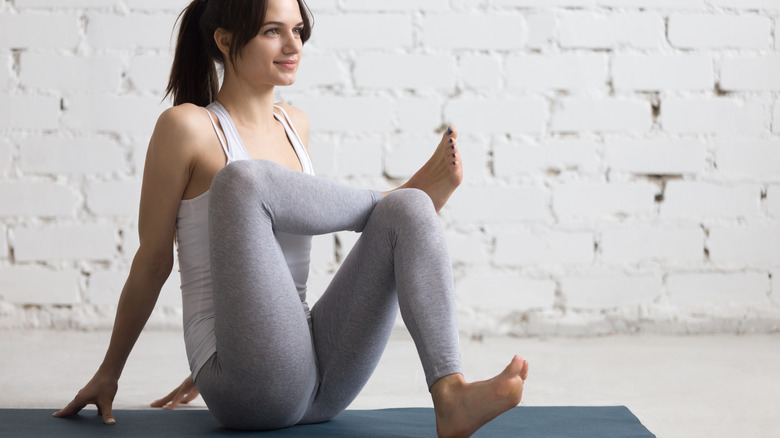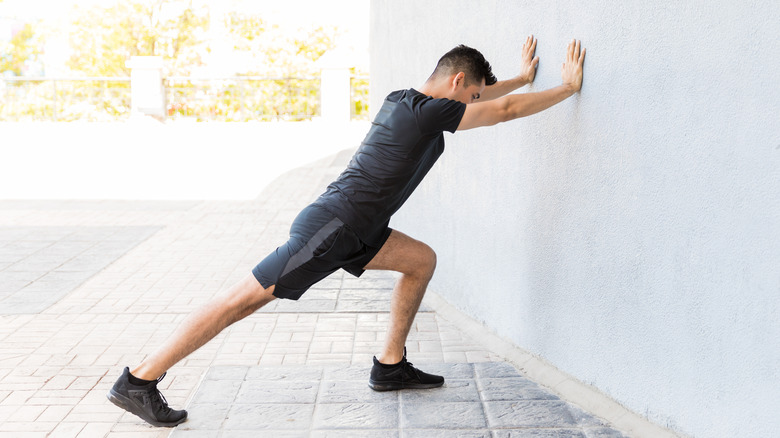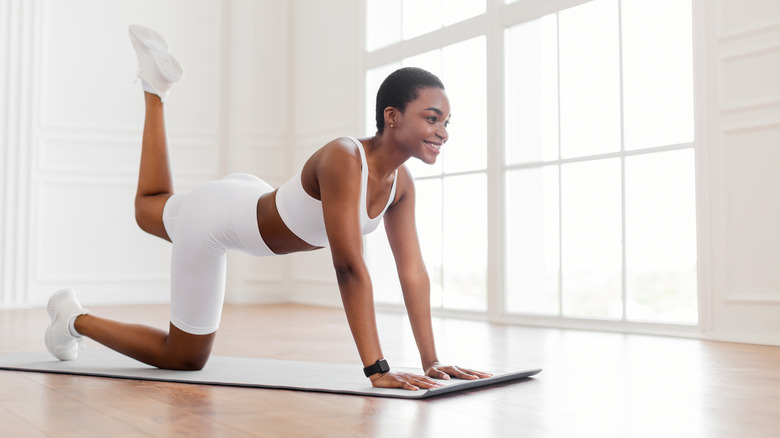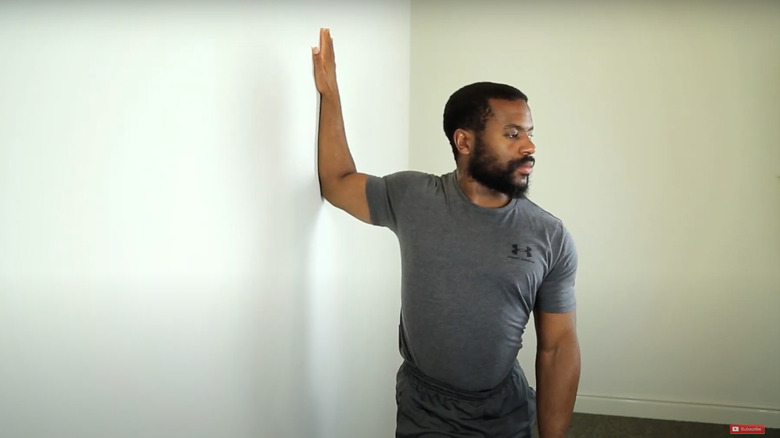Stretches You Should Do Before Working Out
Stretching is seriously underrated, folks. For way too many people, stretching out muscles before exercise is seen as an unnecessary lead-in to the main event of the workout itself — indeed, one 2021 survey published in the International Journal of Environmental Research and Public Health suggests that about 50% of people don't stretch prior to a workout (though the results did show that more than 70% of the respondents do stretch after exercise). But stretching before a workout to warm up and prepare your body for movement has benefits that cannot be overstated, regardless of the exercise you're taking part in. "Whether you're a runner or a strength athlete, warm-ups are super important," says "Disabled Girls Who Lift" podcast co-host and physical therapist Marcia Denis to Self. "They are great for priming your body for movement, and they also give you an opportunity to check in mentally and physically."
Not only does a good stretch feel good, but doing so before exercise prepares your muscles by improving flexibility and extending their range of movement before you go whole hog on a workout — and this enhances your performance and limits the risk of injury (per The Orthopedic and Sports Medicine Institute). But if you're accustomed to jumping straight into your exercise routine without stretching, you might be a little confused as to where to start. Well don't worry — we've got you covered. Here are the best stretches you can do before a workout.
Downward dog
If you're getting ready to hit the gym, few stretches prepare you better than the downward dog. This fundamental yoga pose provides a stretch throughout multiple parts of your body, targeting and activating your hands, arms, back, calves, hamstrings, and feet, according to Daily Burn. The downward dog is also particularly useful as a pre-workout stretch thanks to its upside-down nature. "All inverted poses, where your heart is above your head, encourage blood flow and serve to both energize and calm your body," says Core Fusion and senior yoga teacher Lauren Weisman to Daily Burn. We like the sound of that!
To do a downward dog, begin on your hands and knees, with your limbs stacked beneath your hip and shoulder joints, says Verywell Fit. Place your toes on the ground and push your body up and back until your butt's in the air and your legs are straight. Allow your heels to sink into the floor as much as possible, and make sure your quads stay activated so that you're not putting too much pressure on your upper body. To increase the stretch through your hamstrings, you can pedal your feet into the ground.
Lunge with side bend
If you're a runner, you'll be familiar with those stiff first steps out of the door (especially if you're heading out on a jog after a long day working from home ... yes, okay, we are speaking from experience here). Stretching before you run, however, is an essential step in keeping your workout safe and effective. "With a proper warmup, you decrease your likelihood for injury and also give yourself the adequate time to prepare mentally for the load you're about to endure," says Mile High Run Club's head coach and certified personal trainer Corinne Fitzgerald to Runner's World. By increasing the blood flow to your legs and throughout your body, and warming up your joints, you're in a much better position to fly around the track.
A lunge with a side bend warms up one leg at a time. Stand with your feet shoulder-width apart, hands on your hips, and take a large step forward. Bend your front knee until your thigh is parallel to the floor, making sure that your knee doesn't extend over your calf. Once you're in the lunge position, take the arm on the other side of your body (so, if you stepped forward with your right, your left arm, or vice versa), raise it above your head, and then tilt it over your body, feeling the stretch through your side. Hold for a few seconds, return to standing position, and repeat on the other side.
Seated clasped neck stretch
When we work out, we tend to focus on the bigger muscles. But we need to make time to care for our smaller muscles too, even if we're not targeting them in the gym. Our neck muscles can end up picking up a lot of slack when we work out, often due to incorrect posture, and this can result in neck pain and strain (per Harvard Health Publishing). Stretching out our neck may alleviate any neck discomfort or tension we feel, both as a result of exercise and in our everyday lives, says Self.
The seated clasped neck stretch will target the back of your neck, specifically your trapezius muscles, while also providing a stretch for your upper back. Start by sitting down, either in a chair or on the floor, with your upper body straight and tall. Place your hands on the back of your head in a clasped position and apply gentle pressure, feeling the stretch through the back of your neck. Breathe in and out deeply, holding the stretch for 30 seconds or so before releasing. You can also do the stretch with one hand if you find that both hands are too much.
Cat stretch
We make no secret of the fact that we've got a lot of time for stretches that have animal names (honestly, there's no reason for it, we just really like our pets). And the cat stretch isn't just great because it's named after your favorite furry pal — it also delivers a serious stretch through your back, according to Livestrong. The cat stretch helps to activate your spinal area, which tends to be heavily involved during a range of workouts, from weightlifting to running, thereby assisting with flexibility and injury prevention.
Begin the cat stretch on your hands and knees, making sure that your hands are placed under your shoulders, and your legs under your hips. On an exhale, slowly round your back, allowing the center of your spine to move upward into a semi-circular position. Then inhale and drop back down, arching your back in the opposite direction, working through the spine as you do so. Repeat ten times.
Cobra pose
Our abs get in on the party pretty much every time we work out, whether we're targeting them directly or not. This group of muscles, including our obliques, rectus abdominis, and traverse abdominis, aid in enabling correct, healthy movement, supporting our spine, and taking unnecessary pressure off our backs (per Healthline). That's why warming them up pre-exercise is vital, with dynamic stretches assisting in providing mobility for the area. The cobra pose is the ideal movement for this, delivering a sizeable stretch through the abs and down to the hips.
Begin your cobra pose by lying flat on the floor, face-down. We'd recommend putting an exercise mat down, for comfort (and so you're not sticking your face straight into your floor, natch). Place your hands palms-down on the floor next to your chest on either side of your body, and use them to gently push your upper body off the floor, stretching through your ab muscles. At the top of the pose, hold the stretch for 20 seconds or so, and then gently lower yourself to the ground, repeating several times.
Controlled articular hip rotations
Stretching before exercise isn't just about tending to our muscles — it's also about spending time with our joints. Working through your larger joints, like your hips, is especially important before working out, particularly if the exercise you're going to do will impact them significantly. For runners, controlled articular hip rotations (try saying that three times quickly) will give your hips the love they need. "These help you assess and improve your range of motion and lubricate the hip joint," states certified personal trainer and running coach Corinne Fitzgerald to Runner's World. She adds, "They also increase mobility, which will be beneficial not only for your immediate workout but also for your joint health in the long run."
Begin by standing feet shoulder-width apart, and then raise one of your legs from the knee, until your thigh is parallel to the floor. Keeping your hands on your hips, start to slowly rotate your upper leg in an outward direction from your body, keeping your core activated to maintain your balance. If it helps, imagine that your knee is drawing a big circle, and make sure you're moving through the hip joint. Repeat ten times, and then switch to the other side, alternating back and forth for a minute or two.
Bird-dog crunch
Stretching as a pre-workout warmup is a great way to get prepped for exercise without overdoing it too early. "Warm-ups shouldn't be stressful or wear your muscles out," advises physical therapist Claire Denis to Self. And importantly, certain stretching exercises aid our body in activating certain functions that help is perform our full workouts to their full potential. One such function is core stability, which allows us to maintain form during physical activity (per Bridge Athletic).
A bird-dog crunch helps you do just that (via Self). From kneeling on your hands and knees, simultaneously extend one arm and the opposing leg out from your body, forward and backward, respectively. Ensure that your back remains flat and that your hips don't rotate. Then, pull your knee and elbow into your body to meet each other, activating your abs while you do so. Return your limbs to the extended position, and repeat the movement several times. Finally, do the same movement on the other side.
Arm circles
If you're looking to gain jacked arms and shoulders, strength training is a pretty good way to go about it. But before you pick up those weights, you better make sure you're getting in a good stretch. "When you are performing strength-training exercises, your muscles shorten and lengthen, and if they aren't warm or 'prepped,' your muscles are more prone to tear and pull," according to Rumble Boxing founding trainer and NASM-certified personal trainer Danielle Burrell via Self. A good upper-body stretching warm-up also enables your body to — quite literally — get warmer. Your body temperature will rise, making your tissue more mobile, thereby increasing your performance.
A dynamic stretch, arm circles can help prep your arms and shoulders before you pick up those dumbbells (per MedicineNet). Begin standing with your feet comfortably apart, and raise your arms to either side of your body so that they're parallel to the floor. Gently rotate your arms clockwise, imagining that you're drawing circles with your hands, around 20 times or so, and then repeat in the opposite direction.
Kneeling stretch
Heading out for a run? You're gonna have to stretch those quads, people. "When the leg strikes the ground, the quads control the deceleration. Without them, you'd basically fall," says physical therapist Dr. Alice Holland to Healthline. If you don't prep your quads with some stretching beforehand, they're less able to take the impact of your foot hitting the ground. Ideally, you want to have stretched your quads out enough so that your muscles feel loose and ready as you start running, says Holland.
One of the quickest ways to get your quads in gear before your first step is with a kneeling stretch. From a kneeling position, place one of your feet in front of you, your foot flat on the floor. Gradually lean forward into the front knee, moving your body forward, so that there's a stretch through the quad of the back leg. Hold the position for half a minute, and then switch legs. If the knee on the back leg is uncomfortable from contact with the floor, you can put a cushion under it. To intensify the stretch, you can hold on to the foot of your back leg and pull it gently toward your body.
Lateral lunge with reach
It may not be enough to simply stretch before we work out — it's how we stretch that may be the most important thing. "We know that from studies, just static stretching can sometimes inhibit the muscle activity," thereby potentially limiting the workout we're about to do, warns physical therapist Jen Fraboni to Women's Health. Instead, Fraboni advises using dynamic stretches to warm up, encouraging movement throughout your muscles to get them in a state of readiness.
A lateral lunge with a reach activates pretty much your whole body, using constant motion to get your upper and lower regions prepped for exercise. Begin by placing your feet in a wide stance. Take one hand, and then reach it down toward the opposing foot, lunging to the side as you do so. Move over to the other side, and repeat the movement with the other hand and foot, alternating lunges and reaching at a good pace for around 60 seconds.
Seated glute stretch
How often do you stretch your glutes? Not enough, we'd wager — and especially not before exercise. But considering how much your glutes are involved during exercise, with the muscle group taking part in almost every lower body movement, stretching them before a workout is crucial to ensure adequate blood flow throughout the area and increase its range of motion (per Healthline).
And you can't get much simpler than a seated glute stretch. Sit on the floor and place your legs out in front of you so that they're flat on the ground. Take one leg and fold it over the knee of the other. Ensure that your back doesn't bend over while you do this. Pull up the ankle of the folded leg slightly, and then lead forward gently into the stretch to get a better activation through the glute. To get a further stretch, you can bend the leg on the floor. Stay in the stretch for 20 seconds or so, repeating on the other side. As sitting on the floor can be difficult for some folks, try a yoga block or a cushion if you need a little extra help.
Lunging calf stretch
One important muscle group you may be neglecting: your calves. "People tend to forget to stretch smaller muscles that are further away from the trunk of their body," says Barry's Bootcamp instructor and certified personal trainer Sarah Otey to Self. And unfortunately, tightness in the calf muscles can cause some significant impacts on our workouts, from limiting our mobility during certain movements like squats to increasing our likelihood of developing injuries like shin splints, Achilles tendonitis, and plantar fasciitis.
Nip these issues in the bud by stretching your calves out before exercise with a lunging calf stretch — this stretch is easily achievable anywhere, anytime, according to Otey. Stand with your feet hip-width apart, with your palms placed on a solid surface like a wall (or resting on your hips). Step one of your feet back by about a foot or so, planting it so that your leg is straight. Then gently bend your front leg, pressing your back heel into the ground. If you want an even deeper stretch, you can step your foot back even further. Hold for 20 seconds or so, and then repeat on the other side.
Donkey kick
When you're choosing stretches for your pre-workout routine, you might want to opt for movements that stretch out multiple parts of your body simultaneously to maximize efficiency. With a donkey kick stretch, you'll be activating your core, shoulders, and glutes at the same time, as Self states, as well as getting your blood pumping from the dynamic nature of the stretch. You also get to pretend to be a donkey briefly, which could be fun. If that's your thing. Hey, you never know!
Start on your hands and knees, paying attention to your core to make sure it's activated. With both feet flexed, raise one of your legs up behind you, keeping your knee bent, until your thigh is in line with your body. Keep an eye on any arching in your lower back — it should be straight throughout — and avoid letting your hips rotate too much. Hold the pose briefly at the top, and then lower your knee back to the floor. Complete five reps of each leg.
Bent-arm wall stretch
If it's chest day at the gym, you should be sure not to skip the stretch beforehand. Neglecting to stretch out your chest muscles, though, can contribute to tightness and limited mobility in the area, both during exercise and more generally in day-to-day life (per ACE Fitness). It can also lead to tighter shoulders and poorer posture. More importantly, by introducing movements that generate flexibility before a workout, you'll be able to get your pump on with greater ease.
A bent-arm wall stretch focuses on one side of the chest at a time. Stand next to a wall, or in a doorway. Take one of your arms and rest the inside of your forearm against the wall or doorframe, with your upper arm at a 90-degree angle to your body. Step the opposing leg in front of the other, and lean into thre stretch through your chest. Hold this stretch for around 20-30 seconds, and then repeat on the opposite side.

